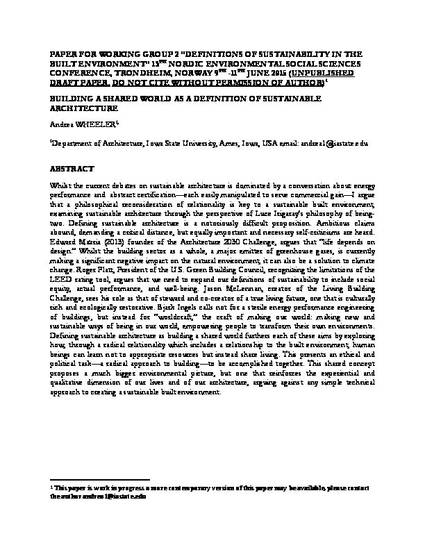
Whilst the current debates on sustainable architecture is dominated by a conversation about energy performance and abstract certification—each easily manipulated to serve commercial gain—I argue that a philosophical reconsideration of relationality is key to a sustainable built environment, examining sustainable architecture through the perspective of Luce Irigaray’s philosophy of being-two. Defining sustainable architecture is a notoriously difficult proposition. Ambitious claims abound, demanding a critical distance, but equally important and necessary self-criticisms are heard. Edward Mazria (2013) founder of the Architecture 2030 Challenge, argues that “life depends on design.” Whilst the building sector as a whole, a major emitter of greenhouse gases, is currently making a significant negative impact on the natural environment, it can also be a solution to climate change. Roger Platt, President of the U.S. Green Building Council, recognizing the limitations of the LEED rating tool, argues that we need to expand our definitions of sustainability to include social equity, actual performance, and well-being. Jason McLennan, creator of the Living Building Challenge, sees his role as that of steward and co-creator of a true living future, one that is culturally rich and ecologically restorative. Bjark Ingels calls not for a sterile energy performance engineering of buildings, but instead for “worldcraft,” the craft of making our world: making new and sustainable ways of being in our world, empowering people to transform their own environments. Defining sustainable architecture as building a shared world furthers each of these aims by exploring how, through a radical relationality which includes a relationship to the built environment, human beings can learn not to appropriate resources but instead share living. This presents an ethical and political task—a radical approach to building—to be accomplished together. This shared concept proposes a much bigger environmental picture, but one that reinforces the experiential and qualitative dimension of our lives and of our architecture, arguing against any simple technical approach to creating a sustainable built environment.
Available at: http://works.bepress.com/andrea_wheeler/20/
